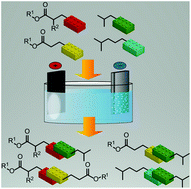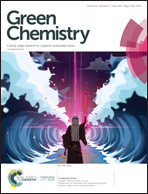Electrochemical cross-coupling of biogenic di-acids for sustainable fuel production†
Abstract
Direct electrocatalytic conversion of bio-derivable acids represents a promising technique for the production of value-added chemicals and tailor-made fuels from lignocellulosic biomass. In the present contribution, we report the electrochemical decarboxylation and cross-coupling of ethyl hydrogen succinate, methyl hydrogen methylsuccinate and methylhexanoic acid with isovaleric acid. The reactions were performed in aqueous solutions or methanol at ambient temperatures, following the principles of green chemistry. High conversions of the starting materials have been obtained with maximum yields between 42 and 61% towards the desired branched alkane products. Besides costly Pt electrodes also (RuxTi1−x)O2 on Ti electrodes exhibited a notable activity for cross-Kolbe electrolysis. As some of the products are insoluble in water, easy product isolation and reuse of the reaction solvent is enabled via phase separation. Several side products have been identified to evaluate the efficiency of the reaction and to elucidate the factors influencing the product selectivity. The yielded alkanes and esters were assessed with regard to their potential as fuels for internal combustion engines. While the longer alkanes constitute promising candidates for the compression–ignition engine, the smaller ester represents an interesting option for the spark-ignition engine.



 Please wait while we load your content...
Please wait while we load your content...